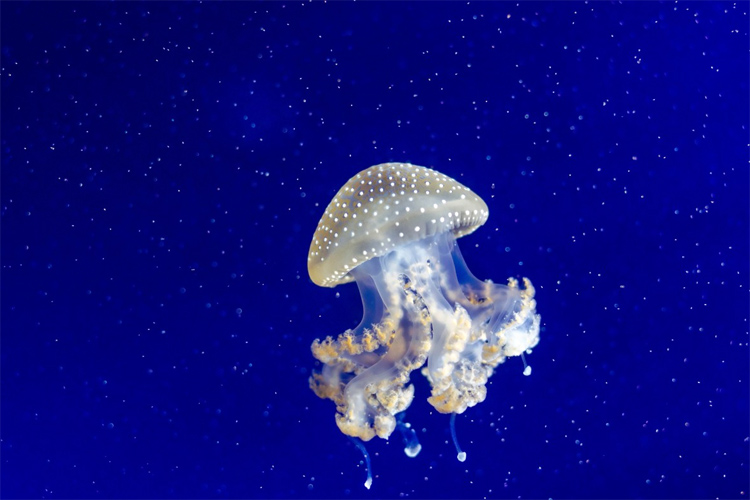The jellyfish is a dangerous carnivorous marine predator. Learn how to treat and soothe the jellyfish sting before it gets painful and harmful.
They don't have teeth, but their small stinging harpoons - the nematocysts - can quickly pierce the human skin and inject poisonous venom.
The jellyfish is one of the 10,000 members of the phylum Cnidaria, which includes the Portuguese man-of-war, the sea anemones, and the fire corals.
Jellyfish are soft, and they're 95 percent water. Their tentacles can extend up to 100 feet.
So, how does this translucent, gelatinous creature sting? When swimming or surfing, you'll feel something has brushed your body.
Then, a tingling starts to build. It's time to get out of the water fast.
In fact, a nematocyst discharge occurs in less than a millionth of a second and may continue to inject venom even after a jellyfish has died.

Habitats and Prevention
Jellyfish are marine animals that live off the ocean floor, even though some species may rest on the seabed for a while.
The jellyfish population adapts to the shifting tidal movements and winds and rides currents to its own favor.
These umbrella-shaped animals inhabit the five oceans of the world, but the most poisonous live in the tropics.
In the Philippines, between 20 and 40 people die every year of jellyfish stings. In Spain's Costa Brava, nearly 20,000 swimmers and water sports enthusiasts need to be treated.
On the island of Oahu, the Hawaiian box jellyfish tend to gather in protected bays seven to ten days after a full moon.
This delicate marine predator is also a threat in Northern Australia (Australian box jellyfish) and some regions of Indonesia (Indo-Pacific box jellyfish), especially during the summer months.
If you're surfing in jellyfish-infested waters, you should always wear a wetsuit or a rash guard. They will, at least, protect a large part of your body.
Protect your face, hands, and feet using specially designed lotions and gels that repel and prevent the stings from most jellyfish.
Treating the Jellyfish Sting
The jellyfish sting causes adverse reactions in humans and, ultimately, it can be fatal.
The effect on victims ranges from slight discomfort to acute pain and death. The majority of jellyfish stings are not deadly, but some box jellyfish, like the sea wasp, may be fatal.
Most of them will only cause skin irritation and itching for an hour.
But the Australian box jellyfish - the most dangerous species - can inflict severe stings that may lead to death in about five minutes.
Small women and children are less resistant to the predator's toxic venom.
If you're lucky, you'll end up with a scar and a story to tell.
Have you been stung by a jellyfish? Here's what to do:
- Swim away and exit the water as quickly as you can;
- Do not scratch the skin;
- Rinse the affected skin area with vinegar or saltwater - forget fresh water, hot water, urine, or alcohol;
- Use tweezers to try to remove as many tentacles as possible;
- For most species, rinse the sting with vinegar. For Portuguese man-o-war, blue bottle jellyfish, and Hawaiian box jellyfish, apply hot water for between five and ten minutes;
- Remove the remaining nematocysts using a credit card;
- If, after 12 hours, a rash persists, apply one percent hydrocortisone cream in the affected area and take diphenhydramine 25 mg;
If you're dazed and confused, having difficulty breathing, or start vomiting, call 911 (USA, Canada), 999 (UK), 192 (Brazil), 112 (Europe, India), 111 (New Zealand), or 000 (Australia).
There are also commercial antivenom formulas that soothe and relieve the pain caused by a common jellyfish sting.
